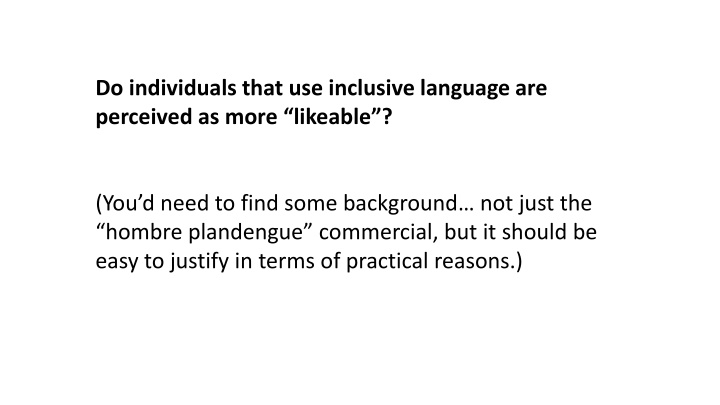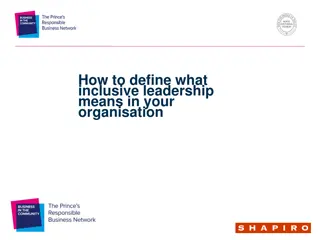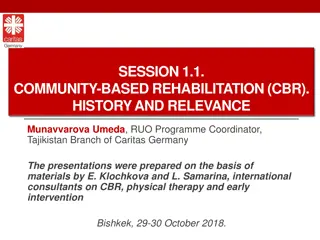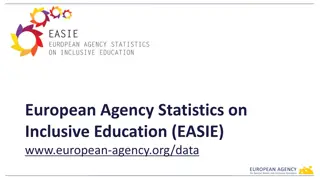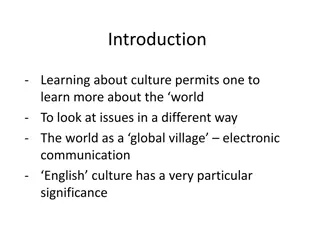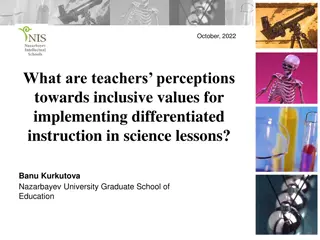Do Individuals Perceive Inclusive Language Users as More Likeable?
This study aims to investigate whether individuals who use inclusive language are perceived as more likeable compared to those using standard language. A randomized experiment will involve participants rating a character in various aspects based on the type of language used in a text, enabling analysis of potential differences in perception. Factors like age, gender, and political views may be controlled to understand their impact on the findings.
Download Presentation

Please find below an Image/Link to download the presentation.
The content on the website is provided AS IS for your information and personal use only. It may not be sold, licensed, or shared on other websites without obtaining consent from the author.If you encounter any issues during the download, it is possible that the publisher has removed the file from their server.
You are allowed to download the files provided on this website for personal or commercial use, subject to the condition that they are used lawfully. All files are the property of their respective owners.
The content on the website is provided AS IS for your information and personal use only. It may not be sold, licensed, or shared on other websites without obtaining consent from the author.
E N D
Presentation Transcript
Do individuals that use inclusive language are perceived as more likeable ? (You d need to find some background not just the hombre plandengue commercial, but it should be easy to justify in terms of practical reasons.)
How can we test this issue? One option . You can prepare ONE short text written by an individual (e.g., Peter) with a standard ( Real Academia ) language, or with an inclusive language. This is the INDEPENDENT VARIABLE: Type of text ( classical vs. inclusive)
Now we need one (or more dependent variables). Lets assume that the participants task is to rate the character (Peter) in a number of variables using a 1-10 Likert scale: -likeable, -intelligent -wealthy -a good leader -social status So we d have 5 dependent variables (we can have others, we can have fewer).
Then you recruit a number of people (lets say 50, we can talk about that later). Randomly, 25 of them will receive the classical text, and the other 25 will receive the inclusive text. All participants will rate Peter in the five questions. Thus we have an experimental design note the randomization procedure this is a between- subjects design (i.e., participants are assigned to only ONE level of the independent variable)
The data analyses will be extremely easy. 50 rows 6 columns (one indicating Type of text; the other 5 indicating the scores for each individual) You can get some plots for the two groups (e.g., box plots, that we will see in a few days), and also get a measure of central location (e.g., mean, median) and a measure of variability (how homogeneous the scores were in each group). And then we need to discuss the findings
Options: Age of the participants. Perhaps 18-25 y.o. participants produce a different effect from people over 30-45 y.o., or also 50-65 y.o. I would keep this variable controlled (i.e., constant). Gender of the participant: Perhaps the male and the female participants will produce a different effect. I would keep this variable controlled (i.e., constant). Gender of the author of the text---it may also matter, of course. Political views. It is likely that the participants political views may affect the findings. Perhaps it would be a good idea so have a score (it may be tricky)
Some of you might argue that, given that participants are assigned to one of the text, there s an extra noise due to individual variation . Is there another possible design? Yes, we can manipulate Type of text in a within-subject design. In this case, we d have to prepare TWO texts, each with the two versions ( classical vs inclusive). Participants would receive a classical text and an inclusive text (50% of participants would receive the classical text first, the the other 50% the inclusive text first).
In this case, the way of presenting the data is a bit different. Let s assume that we have 50 participants 50 rows (as many as participants) 10 columns Likeable (classical), likeable (inclusive), Intelligence (classical), Intelligence (inclusive), and the same for the other 3 dependent variables. Within-subject designs are also called Repeated measures designs.
Advantages of the within-subject design: you need fewer participants to get the same number of observations. Furthermore, each participant is her/his own control (unlike between-subject designs) Potential issues with the within-subject design. It s a bit more complicated (2 versions of each of the text, counterbalancing of the order). Also, participants may guess what the study is about (and then use strategies) and there can be some carry-over effects from the first text to the second text.
